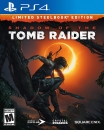Chrkeller said:
Cobretti2 said:
I watched the video and the results are comparable, not identical but good enough. Look at it this way. In once scene it guessed and added too much water reflections, however how would a general gamer know that it did that unless they had a PS5 version of the game and a Switch 2 version of the game side by side and stopped moving and compare pixel by pixel? I'll use a TV show example, many people are mind blown by Buffy 1080p amazon cut for how great it looks, however for those who understand that the original source is 4:3, and they basically cut out a 16:9 image randomly from it and scaled it up, know there is information missing. However the general consumer just remembers watching buffy on VHS and blurry picture now its sharp and crisp but don't realised it is zoomed it and cropped out detail. To make things worse they didn't even reintroduce all the colour corrections to it that were done postprocessing so night scenes look almost daytime, but again the general consumer is none the wiser. Back to your video. In reality there is nothing wrong with the two FSR images unless you are comparing it to the native source. Ok so in one scene the dragon on the wooden box had less detail? big deal, most gamers don't stand around admiring the detail on a wooden box. In the parts where he walked around, they looked comparable in motion and I be happy playing any of those 3 versions. Now the reason PC gamers say it doesn't look great is because of something called consumer bias. Think of it like chocolate, buy a $100 block vs a $5 block. If you know which cost what your brain will automatically bias you into thinking the $100 one tastes better. Same applies to graphics card. In my head I just spent $1500 bux on the latest and greatest, so in my head I'm like oh yer this is much better then upscaling on my old graphics card. Now in reality we know we have reached diminishing returns, so our brain tricks us into thinking it is much better because of the money we spent to justify the purchase in our head. Is the new card better? absolutely, but to say the old one using FSR isn't comparable is just fooling yourself as that video demonstrated how they all look about the same, especially in motion. The image may not be an accurate representation of the native image, but it has managed to construct something a general gamer woudl be happy with as they non the wiser. |
To each their own but not only do I think PC gamers figured out resolution diminishing returns but they figured it way before console gamers did. Think about it. The ps5 and Xbox are pushing for 4k.... PC gamers have long locked at 1440p and are pushing for 120 fps.... because 1440p to 4k is minimal. Meanwhile 30 fps to 120 fps is the grand canyon. PC gamers are also chasing strong effects as seen by Ray tracing. Though perhaps we are saying the same thing. Resolution has hit a ceiling. The future is high fps, RT (when done properly), etc. |
We are talking the same thing. I think the whole argument about comparable is talking from visuals perspective only and not performance. As we saw in that video they look similar, and that might be what the dev may have meant.
Now looking the same but running at 30fps, 60fps, 120fps is the difference that we are actually contemplating. I don't think comparable even factored that aspect of the game in. Visually it may look close as was reported. Hell I saw another post in here earlier showing FFVII running on a steamdeck and that looks pretty good to me visually.
The other thing that hasn't really been talked about is depth is optimisation. What the hardware can do and what developers choose to do are two different things. The demo would have been optimised to the Nth degree to show case the hardware for a sales pitch, however one developer may choose to take the time to do it well and get comparable visual results to PS5, but we know most devs (or more so their publishers) from past history, will not want to invest too much money and time into porting to a Nintendo platform, we have seen some shoddy efforts on Switch. We can only hope that with DLSS features, that they may put some effort in to at least get it working well with it.
People also forget that the PS5 games of today aren't exactly mind blowing because they are cross gen or perhaps it's purely financial and devs don't want to invest too much into it. There was some impressive demos shown for the PS5, but most games are yet to look anything like those demos, so what is that reason? So the comparable statement could be accurate for what is out today.
Another good example of effort can be seen in say h265 video encodes. If you use hardware acceleration of the gpu to do he encoding, you loose quality vs the much slower CPU encoding, if you are targeting the same file size as an example. That is why you always see a rushed release file that in reality could be 3x smaller if encoded the slow way at a much smaller bitrate.
























































